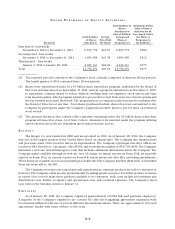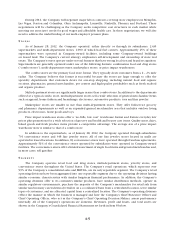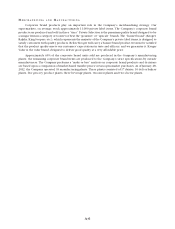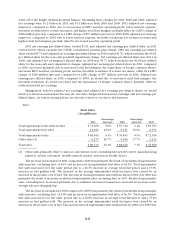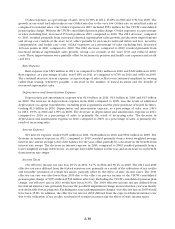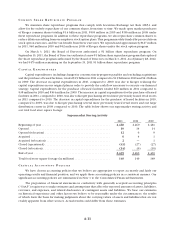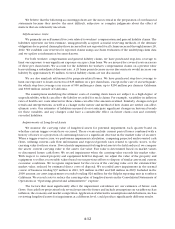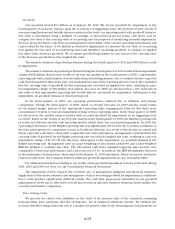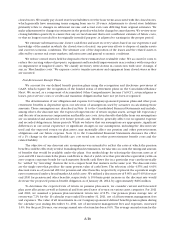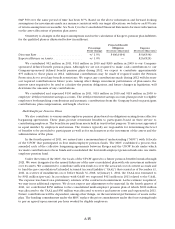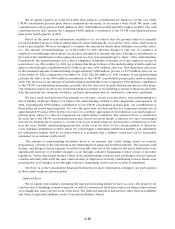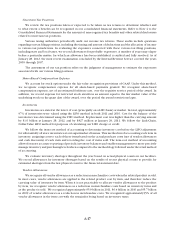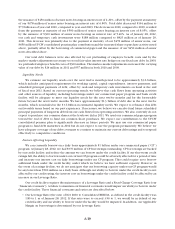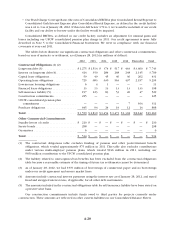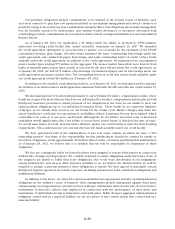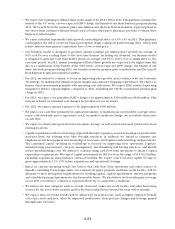Kroger 2011 Annual Report Download - page 69
Download and view the complete annual report
Please find page 69 of the 2011 Kroger annual report below. You can navigate through the pages in the report by either clicking on the pages listed below, or by using the keyword search tool below to find specific information within the annual report.A-14
closed stores. We usually pay closed store lease liabilities over the lease terms associated with the closed stores,
which generally have remaining terms ranging from one to 20 years. Adjustments to closed store liabilities
primarily relate to changes in subtenant income and actual exit costs differing from original estimates. We
make adjustments for changes in estimates in the period in which the change becomes known. We review store
closing liabilities quarterly to ensure that any accrued amount that is not a sufficient estimate of future costs,
or that no longer is needed for its originally intended purpose, is adjusted to earnings in the proper period.
We estimate subtenant income, future cash flows and asset recovery values based on our experience and
knowledge of the market in which the closed store is located, our previous efforts to dispose of similar assets
and current economic conditions. The ultimate cost of the disposition of the leases and the related assets is
affected by current real estate markets, inflation rates and general economic conditions.
We reduce owned stores held for disposal to their estimated net realizable value. We account for costs to
reduce the carrying values of property, equipment and leasehold improvements in accordance with our policy
on impairment of long-lived assets. We classify inventory write-downs in connection with store closings, if
any, in “Merchandise costs.” We expense costs to transfer inventory and equipment from closed stores as they
are incurred.
Post-Retirement Benefit Plans
We account for our defined benefit pension plans using the recognition and disclosure provisions of
GAAP, which require the recognition of the funded status of retirement plans on the Consolidated Balance
Sheet. We record, as a component of Accumulated Other Comprehensive Income (“AOCI”), actuarial gains or
losses, prior service costs or credits and transition obligations that have not yet been recognized.
The determination of our obligation and expense for Company-sponsored pension plans and other post-
retirement benefits is dependent upon our selection of assumptions used by actuaries in calculating those
amounts. Those assumptions are described in Note 13 to the Consolidated Financial Statements and include,
among others, the discount rate, the expected long-term rate of return on plan assets, average life expectancy
and the rate of increases in compensation and health care costs. Actual results that differ from our assumptions
are accumulated and amortized over future periods and, therefore, generally affect our recognized expense
and recorded obligation in future periods. While we believe that our assumptions are appropriate, significant
differences in our actual experience or significant changes in our assumptions, including the discount rate
used and the expected return on plan assets, may materially affect our pension and other post-retirement
obligations and our future expense. Note 13 to the Consolidated Financial Statements discusses the effect
of a 1% change in the assumed health care cost trend rate on other post-retirement benefit costs and the
related liability.
The objective of our discount rate assumptions was intended to reflect the rates at which the pension
benefits could be effectively settled. In making this determination, we take into account the timing and amount
of benefits that would be available under the plans. Our methodology for selecting the discount rates as of
year-end 2011 was to match the plan’s cash flows to that of a yield curve that provides the equivalent yields on
zero-coupon corporate bonds for each maturity. Benefit cash flows due in a particular year can theoretically
be “settled” by “investing” them in the zero-coupon bond that matures in the same year. The discount rates
are the single rates that produce the same present value of cash flows. The selection of the 4.55% and 4.40%
discount rates as of year-end 2011 for pension and other benefits, respectively, represent the equivalent single
rates constructed under a broad-market AA yield curve. We utilized a discount rate of 5.60% and 5.40% for year-
end 2010 for pension and other benefits, respectively. A 100 basis point increase in the discount rate would
decrease the projected pension benefit obligation as of January 28, 2012, by approximately $406 million.
To determine the expected rate of return on pension plan assets, we consider current and forecasted
plan asset allocations as well as historical and forecasted rates of return on various asset categories. For 2011
and 2010, we assumed a pension plan investment return rate of 8.5%. Our pension plan’s average rate of
return was 7.2% for the 10 calendar years ended December 31, 2011, net of all investment management fees
and expenses. The value of all investments in our Company-sponsored defined benefit pension plans during
the calendar year ending December 31, 2011, net of investment management fees and expenses, increased
1.6%. For the past 20 years, our average annual rate of return has been 9.4%. The average annual return for the


